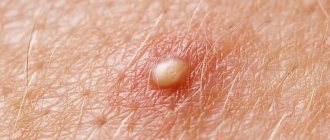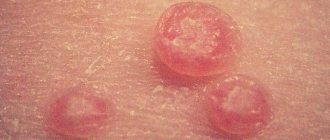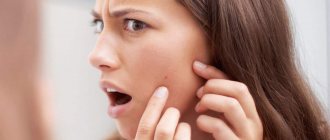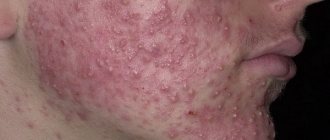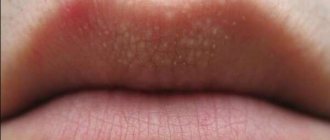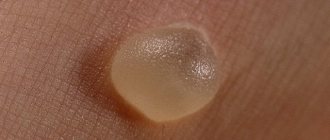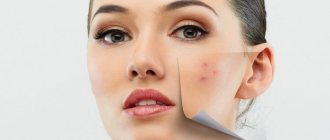Why do they appear?
The reasons why pustular rashes can appear on the face or body (on the forehead, nose, back, chest, butt, neck, etc.) are divided into the following:
- Excessive secretion of subcutaneous fat by the sebaceous glands.
- Hyperkeratosis, characterized by thickening of the stratum corneum of the skin and its enlargement. As a result of the overflow of the sebaceous glands with bacteria, an inflammatory process begins, which leads to the formation of pus.
- Use of antibiotics and steroids in large quantities.
- Changes in normal hormonal levels in girls.
- Poor personal hygiene and lack of appropriate skin care.
- Passion for cosmetics. Very often, acne on the face (for example, on the forehead) is associated with excessive application of foundation to the skin.
- Prolonged nervous overstrain and stressful situations.
Red pimple with white head
Among dermatological problems, acne with a white-yellow head is very common. Why do they appear on the body and face, what other signs does the pathology have and how to treat it - it is better to contact a specialist with these questions.
Causes and mechanisms
Pimples with yellow contents are a sign of pyoderma or acne. Pustular elements appear due to bacterial flora, namely staphylococci. These are opportunistic organisms that live on the skin and scalp of many people. But not everyone gets pustular rashes, because the development of such acne is promoted by:
- Damage (cuts, abrasions, excoriation, burns, maceration).
- Pollution (dust, fuels and lubricants, physiological secretions).
- Hypothermia and overheating.
- Insufficient nutrition and vitamin deficiencies.
- Endocrinopathies (diabetes mellitus, hypothyroidism).
- Diseases of the digestive tract.
- Immunodeficiencies.
As we can see, the decisive role in pyoderma belongs to the decrease in the activity of local and systemic protective factors. Under such conditions, microbes easily penetrate the mouths of hair follicles, begin to multiply there and provoke an inflammatory reaction.
Acne occurs due to a combination of several factors: increased production and impaired sebum secretion, hyperkeratosis and accumulation of propionobacteria.
Skin pores become clogged with fatty deposits and horny cells, which creates favorable conditions for the development of microbes.
The appearance of acne is promoted by hormonal changes in the body (usually during puberty).
Pimples with a white head are superficial pyoderma caused by bacterial flora, or acne on the face that occurs when sebaceous secretion is impaired.
Symptoms
With superficial pyoderma (ostiofolliculitis), damage to the hair follicle occurs. At first, there is slight hyperemia and induration, painful on palpation.
Then the nodule takes on a cone shape and a pustule is formed. The abscess looks like a red pimple with a white head located at the base of the hair.
After a few days, the contents dry out, and the top of the pustule becomes covered with a crust.
Ostiofolliculitis can be limited or occupy large areas of the body. Such pimples are located in groups, but do not have a tendency to merge. Sometimes individual elements increase to 10 mm in diameter, which suggests another form of pyoderma - Bockhart's staphylococcal impetigo. It often occurs as a complication of scabies.
Pimples on the face, which are a sign of acne, can be of different types. They are represented by the following elements:
- Comedones (open and closed).
- Papules.
- Pustules.
- In knots.
- Cysts.
Comedones are non-inflammatory pimples that appear when the excretory ducts of the sebaceous glands are blocked. The closed elements are white, and the open ones have a black top. They are mainly localized on the forehead and chin. The skin looks shiny and the hair looks oily.
Further inflammation leads to the appearance of papulopustular rashes. Small pustules heal without a trace, while larger ones leave behind scars. The spread of the process deeper is accompanied by the formation of nodes and cystic cavities.
The clinical picture is determined by the cause of acne and the stage of its development. Visual signs form the basis of a preliminary diagnosis.
Additional Research
The results of additional research will help you understand why yellow pimples have formed on your face or body. Based on your specific situation, the following procedures may be necessary:
- General blood analysis.
- Hormonal spectrum.
- Analysis of discharge (microscopy, culture, sensitivity to antibiotics).
Sometimes, to clarify the underlying pathology, it is necessary to consult an immunologist, endocrinologist or gastroenterologist.
Treatment
Superficial pyoderma responds well to external therapy. First, the skin is treated with antiseptic solutions:
- Diamond green.
- Iodine.
- Fukortsin.
- Boric alcohol.
Next, the affected areas are lubricated with antibacterial ointments (chloramphenicol, tetracycline). Systemic therapy is indicated only for extensive and deep pyoderma. Then oral antibiotics, immunotropic agents and vitamins are prescribed.
Acne needs to be treated comprehensively. As local therapy, drugs are used that normalize sebum secretion, reduce the severity of hyperkeratosis and have antimicrobial properties:
- Benzoyl peroxide.
- Azelaic acid.
- Retinoids.
- Antibiotics.
In addition to local effects, it is necessary to normalize hormonal levels, for which oral contraceptives with an antiandrogenic effect are prescribed. Systemic antibiotic therapy is also present in acne treatment regimens.
Pathology can be treated only after establishing a complete picture: identifying the causes, determining the nature and severity of the process.
Pimples with a yellow or white head may indicate pyoderma or acne. These conditions have fundamental differences that must be taken into account for complete and high-quality therapy.
Many people, regardless of gender and age, are uncomfortable with the appearance of acne of various types. Among them are the most unaesthetic and extremely painful pimples with white heads, which are considered the final stage of the appearance and development of acne.
The accumulation of fatty substances, dead skin remnants and harmful bacteria are ready to break out at any moment. Most often they appear on the face; areas where more fat is formed (chin, nose, forehead) are affected.
They can also be found in the back or chest, on the arms and shoulders. In any case, regardless of the location of formation, the appearance of an inflammatory process on the skin cannot be ignored, as this is a danger signal for the entire body.
It is necessary to carry out comprehensive measures to eliminate the problem area.
Source: https://spina-sustav.ru/medicina/krasnyj-pryshhik-s-beloj-golovkoj.html
Reasons for appearance
There are many reasons why a purulent pimple may appear on any part of your body. The main ones, of which are considered:
- Excessive secretion of subcutaneous fat by the sebaceous glands, when the secreted amount begins to exceed the permissible norm, the ducts (pores) become clogged, which, in turn, leads to the fact that purulent acne begins to appear on the body. For this reason, pustules most often occur in adolescents during puberty.
- Hyperkeratosis is considered another of the main causes; it is characterized by thickening of the stratum corneum of the skin; in addition, its increase is observed. Overcrowding of the sebaceous glands with bacteria, in turn, leads to an inflammatory process, followed by suppuration.
- Taking large amounts of antibiotics and steroids also affects your skin, and some medications can cause pimples called medicinal acne.
- As a result of hormonal imbalance (changes in hormonal levels) in girls during menstruation, during pregnancy or after it. In most cases, it is a few days before the start of menstruation that purulent pimples begin to appear one by one or several at a time.
- Lack of appropriate (individually for your skin type) and regular skin care, it is our laziness that can cause the appearance of purulent acne, so you need to shower twice a day and do not forget about washing your face.
- Cosmetics often cause large purulent pimples to appear on your face. There is no need to apply a large amount of foundation or powder on your face, and if you are still keen on this activity, then you should carefully select them, based on the condition of your skin, and also do not forget to wash it all off before going to bed.
- Stressful situations and prolonged nervous tension have a negative impact on the condition of our skin.
Is it possible to squeeze out
Doctors strictly prohibit squeezing pimples.
After removing the rash, there is a risk of unpleasant consequences. The main complications include:
- the appearance of red and bluish spots;
- scars;
- dark spots.
When squeezing a pimple, the following processes occur:
- Vessels and capillaries are damaged. This leads to the appearance of spots that are most noticeable during the cold season.
- The skin is injured. In this case, scars appear on its surface.
- The purulent contents of pimples enter the bloodstream and spread throughout the body through the vessels.
- Skin hyperpigmentation appears.
Types of pustules
There are several main types of pustules:
- Pustules. They look like round tubercles filled with pus. The pustules are usually surrounded by red, inflamed skin. Appear singly or en masse.
- Knots. They represent the next stage of development of pustules or an independent type of rash. In this case, inflammation affects the deeper layers of the skin.
- Cysts. They are formed by several pustules, merging into one in the subcutaneous space. Cysts can be quite large and are accompanied by pain.
- Papules. They are small in size and relatively painless
Causes of white pimples on the face or body of a baby
Although in theory it is believed that a baby's skin should be smooth as velvet, in practice this is not always the case. Various spots and irregularities may appear on it. It is not uncommon to have pimples on the face of a newborn with white heads. What could be causing them, and is it possible to fix it?
Acne in babies
Causes of pimples
White pimples on a baby's face and body rarely require specialized treatment. As a rule, they are short-term and completely harmless. The main reasons for their occurrence:
- If a newborn's white pimples look like blackheads, reddish with white heads (acne), then they may be caused by maternal hormones that affect the baby for some time after birth. They can also occur due to contact with the genital tract that occurred during childbirth.
Important! It has been proven that acne in infants can be caused by contact with a new environment: clothing, bedding, baby cosmetics, diapers, which affect the baby’s delicate skin.
- Another type of acne is milia, or prosyanka, small, dense white papules. The reason for their appearance is the insufficient functioning of the child’s sebaceous and sweat glands;
Milia on baby's face
- Lipophilic yeast (Malassezia) lives on human skin. This yeast-like fungus can colonize the epidermis in the first months of life. If there is a predisposition to atopic dermatitis, it can cause an allergic reaction in the baby and skin rashes.
Rashes on the face
Both acne and millet may appear on the baby's scalp. Blackheads typically do not itch or produce fluid. The places where hormonal acne appears are the cheeks, nose, forehead, chin, sometimes the ear and the hairy part of the head. They do not appear on the arm or leg.
If a newborn has white pimples on the skin of the eyelids, their causes may be:
- poor functioning of the sebaceous glands;
- contact with irritants (prolonged exposure to sunlight can also irritate the skin of an infant);
- lack of calcium at the time of teething.
Sometimes white pimples appear on the tongue and gums of a newborn. Their reasons may be:
- stomatitis due to infection in the baby’s mouth, and red pimples near the throat may be observed;
- thrush (characterized not by pimples, but by a white coating);
- pimples on the palate sometimes indicate dysbiosis.
Rash on other parts of the body
If there are white pimples on the child’s genitals (testicles in boys or labia in girls), possible causes are imperfect functioning of the sebaceous glands, diaper dermatitis, infections.
Pimples can also mean a skin allergy, most often a contact one, for example, to detergents used to wash clothes. Sometimes pimples appear along the edges of the diaper on the legs, closer to the groin.
In this case, there will be redness of the skin, and the pustules will be pink, without tips, filled with fluid.
Their appearance is accompanied by itching, which is a contact allergy to the diaper material.
What parents should do when pimples appear
Red spots on the face of a newborn baby
Important! If your child has acne, you need to make sure that the baby does not overheat. This is essential to keep your skin in good condition. When a baby is too warm, skin changes worsen.
The ambient temperature must be maintained at 20-22ºC. The skin on the back of the baby's head should be warm and dry. The bath must be taken at a temperature no higher than 37ºC.
What can you do
If your baby has pimples with white heads on his face or body, you can:
- When bathing, use potassium permanganate in low concentration;
- Care for your baby’s facial skin every day by wiping it with a cotton pad moistened with boiled water;
Washing a newborn
- A decoction of the string has a good effect on the skin. It is added to the bathtub for bathing the baby or, during hygienic procedures, it is treated with cotton wool dipped in a herbal decoction on areas where redness and pimples appear.
What should you be wary of?
White pimples in a newborn usually do not require a visit to the doctor. However, you should contact your pediatrician or pediatric dermatologist if:
- The child has purulent rashes. The doctor may start treating them with antibiotic ointment. Its use is necessary due to the risk of generalization of infection;
- Despite proper hygienic care, acne does not go away and even increases;
Rash growth
- Acne lesions appear in unusual places: they are not observed on the face, but only in the armpit, in the crooks of the arms, groin, and on the neck.
Important! The doctor may recommend a zinc suspension (Tsindol), which has an anti-inflammatory and slightly drying effect, to smear on the pimples.
When purulent pimples form and spread, if timely measures are not taken, the following complications may arise:
- streptoderma - a bacterial infection, especially often occurring in the diaper area and skin folds;
- furunculosis.
What is prohibited to do
Milia in a newborn appear as a result of clogged skin pores. These are stagnant epidermal cysts resulting from the accumulation of sebaceous masses. Such formations are not treated, are not lubricated, and it is strictly forbidden to squeeze them, because this can lead to infection and abscess. After a few days or weeks, milia go away on their own.
Cannot be used to treat pimples:
- strong solution of potassium permanganate;
- brilliant green;
- products containing alcohol;
- Fukortsin;
- fatty and hormonal ointments.
It is also not recommended to pour baby powder directly onto your child's pimples.
Important! You cannot independently prescribe antihistamines, antibiotics, or sorbents to your baby.
Emollients used to wash the baby (baby emulsions, gels and bath liquids) can be used for baby hygiene. They do not cause dry skin, do not disturb its delicate protective barrier, and even strengthen it and accelerate healing.
Folliculitis and boils are types of purulent acne
The surface of the human body is not sterile; bacteria, microscopic fungi, and viruses are always present on the skin and in the pores. They help perform protective functions and regulate the body's immune-inflammatory response. The activity of microflora increases in the presence of moisture, when people sweat, and when the pH of the skin changes. In such cases, folliculitis, a purulent inflammation of the hair follicle, can occur on the hands. A pink or red pimple () forms at its mouth.
Signs of folliculitis:
- increase in local temperature;
- redness;
- edema.
Increased proliferation of certain types of bacteria is why purulent pimples-boils appear on the face. These are large white or yellowish blisters with a red, inflamed base.
How to get rid of purulent acne
Pustular pimples can ripen on your skin for quite a long period of time, which is why their owners begin to wonder how to draw pus out of a pimple or how to treat purulent pimples in general. If you have not delayed the process too much, and surgical intervention by a specialist has not yet become necessary, you can try means by which you can get rid of them yourself.
Self-treatment of purulent pimples in most cases comes down to the fact that their owner decides to open the pimple in order to remove its purulent contents. Before you begin this procedure, you should think about the consequences it may lead to.
In some cases, after squeezing out an abscess, scars or scars remain on the skin, which will also spoil your appearance and are even more difficult to get rid of.
If you nevertheless decide to open and squeeze out a purulent pimple yourself at home, then you should take disinfection measures with great responsibility. Before and after the procedure, it is imperative to disinfect not only the skin, but also the hands. After you squeeze out the purulent contents of the pimple, you need to treat the wound with appropriate means; this procedure also takes place when the pus comes out on its own.
Pharmacies sell special ointments that are best used in this situation; the most effective among them are Zinerit, Skinoren, Dalatsin and Baziron. The application of ointments does not have to be spot-on; you can distribute them evenly over the entire face if you have purulent acne on the cheeks and in large quantities, but before applying it is necessary to treat the skin with hydrogen peroxide in order to disinfect it.
If you discover inflammation, which over time will develop into an abscess at the initial stage, then the autopsy procedure may not be required. If the inflamed red spot that appears on your skin is painful, it is recommended to treat it with iodine solution. Dip a cotton swab in iodine and apply it pointwise to the spots, most often so that the inflammation goes away for 5 days.
During this period, due to the influence of iodine, the purulent contents will be drawn out and released out, although in some situations, thanks to the iodine solution, the inflammation goes away and the pimple disappears from your skin. If you are embarrassed by the presence of orange spots on your face, then use concealers before going outside, just do not cover the pimple with a band-aid, trying to “suffocate” it.
Among the houseplants most of us must have is scarlet, a medicinal plant with dense and fleshy green leaves that are slightly prickly. If you do not have such a flower, then you can purchase it at any flower shop at an affordable price. In order to get to the pulp, it is necessary to make a transverse cut on the cut aloe leaf, after first removing a little needle from the edges of the leaf.
After this, there will be pulp on one side and hard skin on the other; this is what should be applied to the purulent pimple and secured with a band-aid. When choosing a patch, you should choose those that have bactericidal gauze on the inside, this will help drain the purulent contents of your pimple. In addition, there must be holes on the patch itself so that the pimple can breathe; otherwise, as a result of it steaming under the patch, the pimple will not ripen, but, on the contrary, will go inside.
It will be more effective to carry out this procedure before going to bed, since most often one night is enough, and if you do it during the day, it will take from 2 to 3 days. The effectiveness of treating purulent acne with aloe is much higher than using ichthyol ointment.
If you decide to use Vishnevsky ointment to fight purulent pimples, you will also need a plaster and a bandage. Cut off a small piece of the bandage and fold it into a pad, onto which you will need to apply ointment, then apply it to the pimple and secure it with a band-aid.
Despite the peculiar unpleasant smell, the effect produced is worth it. Drawing out pus with Vishnevsky ointment usually takes up to 5 days, although a pimple can break out in 1–2 days.
Levomekol ointment, a remedy for purulent acne for external use.
Treatment of the inflamed area with hydrogen peroxide or chlorhexidine.
External agents Baziron, Skinoren gel, Zinerit.
One of the many causes of skin changes is acne or acne. There is a mild form of the disease in the form of blackheads (comedones). With moderate to severe acne, purulent pimples appear on the face and upper torso. Inflammation usually begins with weak immunity, stress, and poor nutrition. Most people suffer from acne between the ages of 10 and 40, and treatment largely depends on the cause and symptoms of the skin changes.
